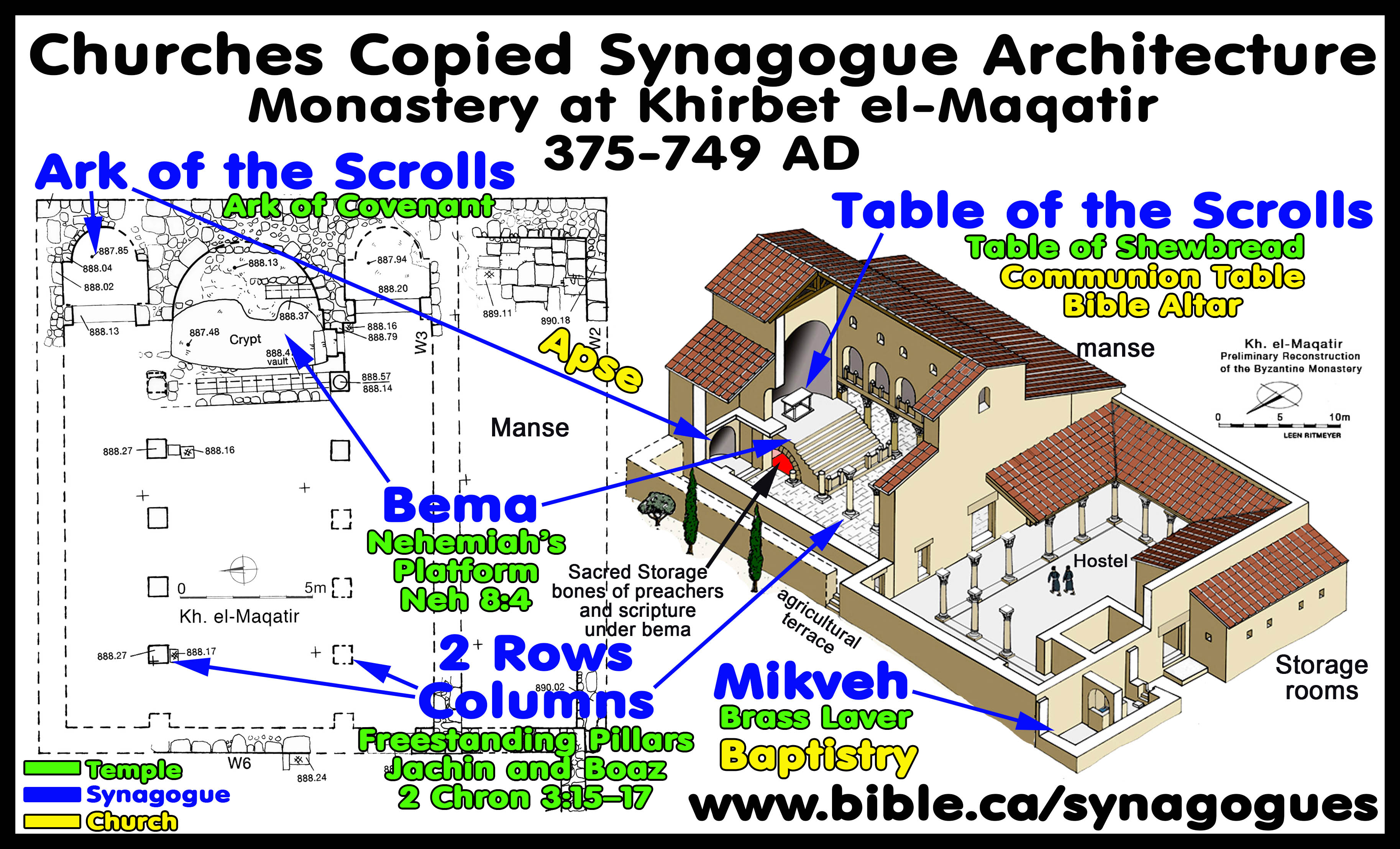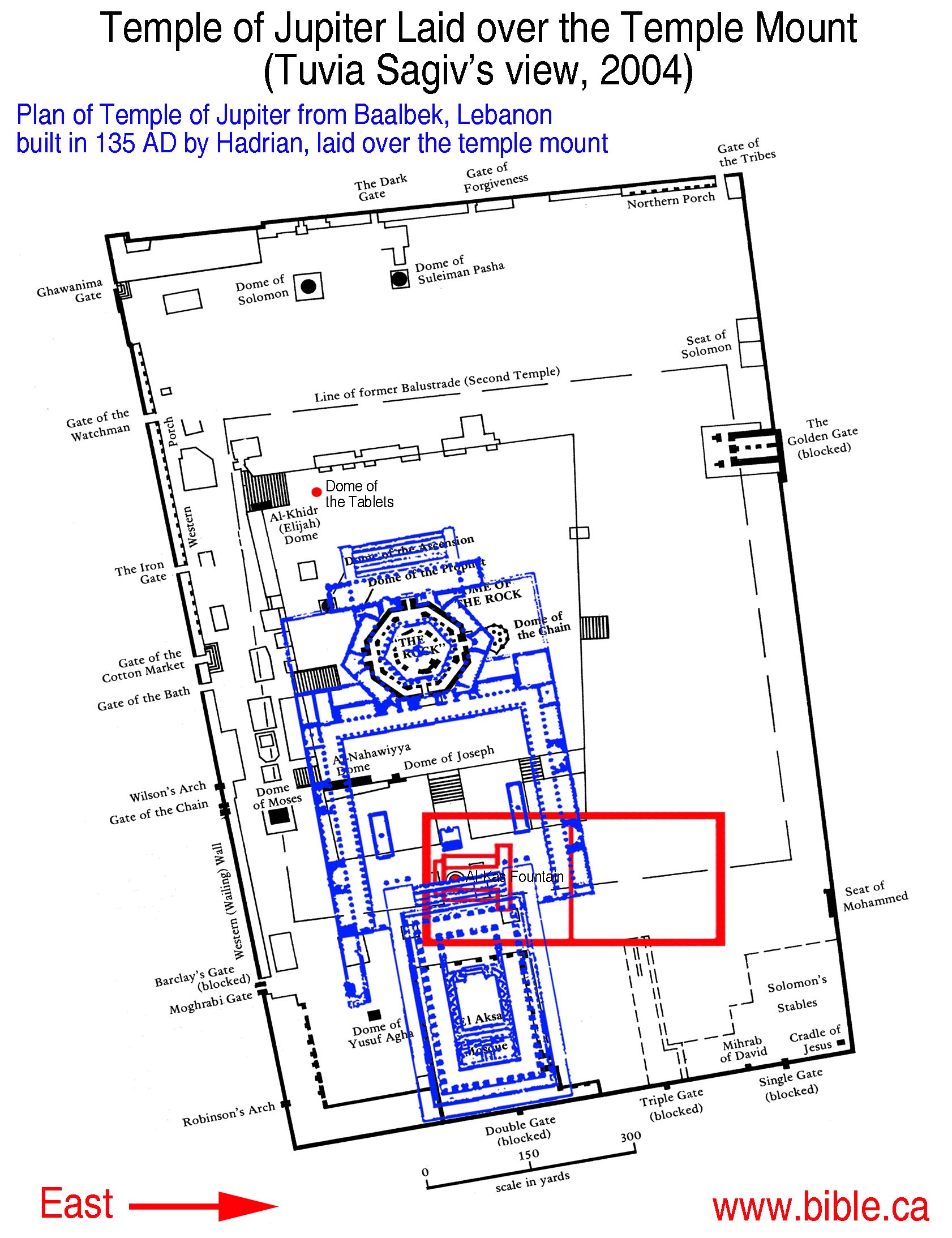East orientation of Jewish temples and altars
Introduction:
- The Temple of Solomon and Herod, was commanded by God through Moses, to be facing east, towards the rising sun.
- Easterly facing temples were unique to the Hebrew religion of Judaism. Pagan temples were oriented in other directions.
- Our calculations show that the sun rises at the temple mount, almost at the true magnetic east, at Passover (April 5).
- We believe that for this reason, magnetic east is in the correct compass setting that the temple of Solomon was aimed at.
- Detailed study of how the Holy of Holies of the Temple of Solomon was located directly over the Al-Kas fountain.
A. Scripture tells us the tabernacle of Moses faced east:
1. It is interesting that the Tabernacle of Moses at Mt. Sinai (Al-Lawz) faced east. If you stood on the summit, you would look east over top of the tabernacle, which itself was facing east.
2. A eastward facing Tabernacle (later Temple) can be inferred from the information about the court in Exodus 27:9-18, with a little help from Numbers 2:1-34 (note vs. 17).
3. "Then he brought me back to the door of the house; and behold, water was flowing from under the threshold of the house toward the east, for the house faced east. And the water was flowing down from under, from the right side of the house, from south of the altar." Ezekiel 47:1
4. "He brought me out by way of the north gate and led me around on the outside to the outer gate by way of the gate that faces east. And behold, water was trickling from the south side." Ezekiel 47:2
5. "For the east side fifty cubits." Exodus 38:13
6. "And these are the measurements of the altar by cubits (the cubit being a cubit and a handbreadth): the base shall be a cubit and the width a cubit, and its border on its edge round about one span; and this shall be the height of the base of the altar." Ezekiel 43:13
7. "Then he went to the gate which faced east, went up its steps and measured the threshold of the gate, one rod in width; and the other threshold was one rod in width." Ezekiel 40:6
8. "Then He brought me into the inner court of the Lord's house. And behold, at the entrance to the temple of the Lord, between the porch and the altar, were about twenty-five men with their backs to the temple of the Lord and their faces toward the east; and they were prostrating themselves eastward toward the sun." Ezekiel 8:16
9. " Moreover, the Spirit lifted me up and brought me to the east gate of the Lord's house which faced eastward. And behold, there were twenty-five men at the entrance of the gate, and among them I saw Jaazaniah son of Azzur and Pelatiah son of Benaiah, leaders of the people." Ezekiel 11:1
10. "As for the gate of the outer court which faced the north, he measured its length and its width." Ezekiel 40:20
11. " Then he led me to the gate, the gate facing toward the east;" Ezekiel 43:1
12. ""For the rear of the tabernacle, to the west, you shall make six boards." Exodus 26:22
13. ""You shall set the table outside the veil, and the lampstand opposite the table on the side of the tabernacle toward the south; and you shall put the table on the north side." Exodus 26:35
14. "Now those who were to camp before the tabernacle eastward, before the tent of meeting toward the sunrise, are Moses and Aaron and his sons, performing the duties of the sanctuary for the obligation of the sons of Israel; but the layman coming near was to be put to death." Numbers 3:38
15. ""Now those who camp on the east side toward the sunrise shall be of the standard of the camp of Judah, by their armies, and the leader of the sons of Judah: Nahshon the son of Amminadab," Numbers 2:3
B. History of Easterly oriented tabernacles, temples and altars:
- The very first tabernacle set up my Moses at the foot of Mt. Sinai (Mt. Lawz in Saudi Arabia) has a large natural open area located east of the mountain that opens to the rising sun. This is one way to determine which side of Mt. Sinai the camp of Israel was located on. In other words, an easterly facing tabernacle would not be located on the west side of a mountain because then it would face the peak, which would shadow the rising sun until about noon. Therefore, the tabernacle at Mt. Sinai must have been located on the east side of the summit.
- "One of the unique aspects of Jewish temples and altars, is their eastern orientation. All Jewish temples and altars face east. No other religion in the Middle has this easterly orientation. Archeologists can easily and immediately identify a Jewish altar in distinction from pagan altars because of this unique fact that they face the rising sun." (Moshe) Contrary to what Moshe told us, there seems to be no archeological pattern in Jewish temples that we can use to guide us on the temple mount. Part of the reason for this, is because so few Hebrew alters have been found.
- Alter of Joshua, for example, does not face due east, but exactly NE or SE. The corners of the altar point to the four points of the compass. "The altar on Mt. 'Ebal is not only the most ancient and complete altar, but also the prototype of the Israelite burnt offering altar of the First and Second Temple periods. The Mesopotamian architectural influence on the structure of the altar is also very interesting, both in its stepped construction and in the orientation of its corners to the north, south, east, and west." (Adam Zertal)
- The temple
at Tel Dan built by Jeroboam, was oriented similarly to the Alter of
Joshua, about 45 degrees off of due east (magnetic north). From
photographs, even the angle of the sunrise is noticeably off the compass.
Keep in mind the Jeoboam's altar was likely deliberately distinct from the
altar in Jerusalem, since he was starting a new religion.

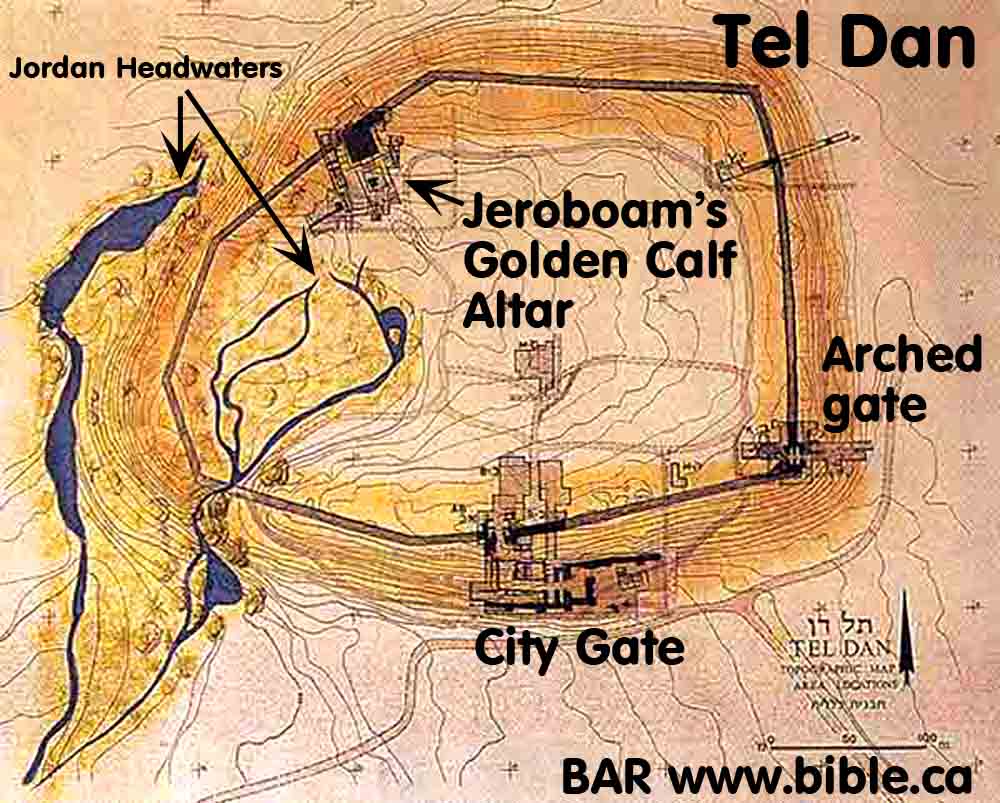
C. Azimuth of sunrise in Jerusalem/Tel Aviv: 30° North
- subtract 20 minutes from all times.
- Israel uses Daylight Saving Time: Add one hour in Summer
- 90 degrees azimuth is due east.
- What we can see is that the sun rises varies 108 Degrees on the sunrise azimuth.
- The azimuth varies 54 degrees north of due east at the winter solstice and 54 degrees south of due east at the summer solstice.
- We also notice Passover is not only very near when the sun rises at magnetic east, but it is almost exactly the midway point between the winter and summer solstice.
- For these reasons, we believe that the compass heading of the tabernacle of Moses and the Temples of Solomon and Herod, were aligned almost exactly at due magnetic east.
Date |
Sunrise Time |
Sunrise Azimuth |
Sunsettime |
SunsetAzimuth |
DaylightHours |
1/1 |
06:55 |
116° |
17:11 |
243° |
10:16 |
8/1 |
06:56 |
115° |
17:16 |
244° |
10:20 |
15/1 |
06:56 |
114° |
17:22 |
246° |
10:26 |
22/1 |
06:55 |
112° |
17:28 |
247° |
10:33 |
29/1 |
06:52 |
110° |
17:34 |
249° |
10:42 |
5/2 |
06:47 |
107° |
17:40 |
252° |
10:53 |
12/2 |
06:42 |
105° |
17:46 |
254° |
11:04 |
19/2 |
06:36 |
102° |
17:51 |
257° |
11:15 |
26/2 |
06:29 |
99° |
17:56 |
260° |
11:27 |
5/3 |
06:21 |
96° |
18:01 |
263° |
11:40 |
12/3 |
06:13 |
93° |
18:06 |
266° |
11:53 |
March 19 |
06:05 |
90° |
18:10 |
270° |
12:05 |
March 26Passover |
05:56 |
86° |
18:15 |
273° |
12:19 |
April 2Passover |
05:48 |
83° |
18:19 |
276° |
12:31 |
9/4 |
05:40 |
80° |
18:23 |
279° |
12:43 |
16/4 |
05:32 |
77° |
18:27 |
282° |
12:55 |
23/4 |
05:24 |
74° |
18:32 |
285° |
13:08 |
30/4 |
05:18 |
72° |
18:36 |
287° |
13:18 |
7/5 |
05:12 |
69° |
18:41 |
290° |
13:29 |
14/5 |
05:07 |
67° |
18:45 |
292° |
13:38 |
21/5 |
05:03 |
65° |
18:50 |
294° |
13:47 |
28/5 |
05:00 |
64° |
18:54 |
295° |
13:54 |
4/6 |
04:58 |
63° |
18:57 |
296° |
13:59 |
11/6 |
04:58 |
62° |
19:01 |
297° |
14:03 |
18/6summer solstice |
04:58 |
62° |
19:03 |
297° |
14:05 |
25/6 |
05:00 |
62° |
19:04 |
297° |
14:04 |
2/7 |
05:02 |
62° |
19:05 |
297° |
14:03 |
9/7 |
05:05 |
63° |
19:04 |
296° |
13:59 |
16/7 |
05:09 |
64° |
19:02 |
295° |
13:53 |
23/7 |
05:13 |
66° |
18:59 |
293° |
13:46 |
30/7 |
05:17 |
67° |
18:54 |
291° |
13:37 |
6/8 |
05:21 |
70° |
18:49 |
289° |
13:28 |
13/8 |
05:26 |
72° |
18:43 |
287° |
13:17 |
20/8 |
05:30 |
75° |
18:36 |
284° |
13:06 |
27/8 |
05:34 |
77° |
18:28 |
281° |
12:54 |
3/9 |
05:37 |
80° |
18:20 |
278° |
12:43 |
10/9 |
05:41 |
83° |
18:11 |
275° |
12:30 |
17/9 |
05:45 |
86° |
18:02 |
272° |
12:17 |
24/9 |
05:49 |
90° |
17:54 |
269° |
12:05 |
1/10 |
05:53 |
93° |
17:45 |
266° |
11:52 |
8/10 |
05:57 |
96° |
17:37 |
263° |
11:40 |
15/10 |
06:01 |
99° |
17:29 |
260° |
11:28 |
22/10 |
06:06 |
102° |
17:22 |
257° |
11:16 |
29/10 |
06:11 |
105° |
17:15 |
254° |
11:04 |
5/11 |
06:16 |
107° |
17:09 |
252° |
10:53 |
12/11 |
06:22 |
110° |
17:05 |
249° |
10:43 |
19/11 |
06:28 |
112° |
17:02 |
247° |
10:34 |
26/11 |
06:34 |
113° |
17:00 |
246° |
10:26 |
3/12 |
06:39 |
115° |
16:59 |
244° |
10:20 |
10/12 |
06:44 |
116° |
17:00 |
243° |
10:16 |
17/12 |
06:49 |
116° |
17:02 |
243° |
10:13 |
24/12winter solstice |
06:53 |
116° |
17:06 |
243° |
10:13 |
D. Compass heading, orientation of temple of Solomon and Herod:
- There is much debate exactly which compass angle the Jerusalem temple of Solomon and Herod was oriented. There are many lines, walls, angles on the current temple mount platform built by Hadrian in 135 AD. It is really a puzzle why the temple mount is trapezoid with so many different lines pointing to different compass headings.
- It is important to remember that the sun rose and with a 100 degree variation on the compass between winter and summer solstice. However the most important time of the year was Passover April and Pentecost (June 1)
- The Temple
mount had an altar that was accessed by a ramp from the south, walking
north. Now the photo below shows the sunrise point, but it does not give the time of year which is critical
and also varies by 108 degrees during the year. However, given the zenith
charts, it is not near Passover.
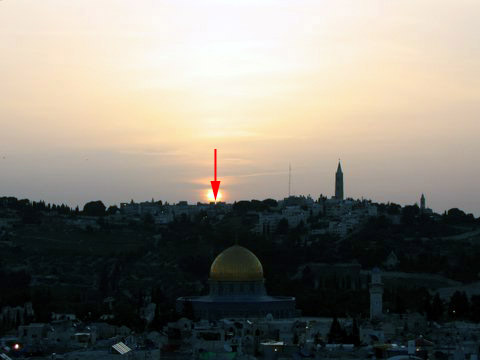
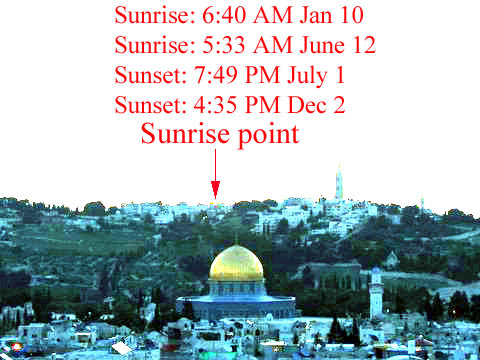
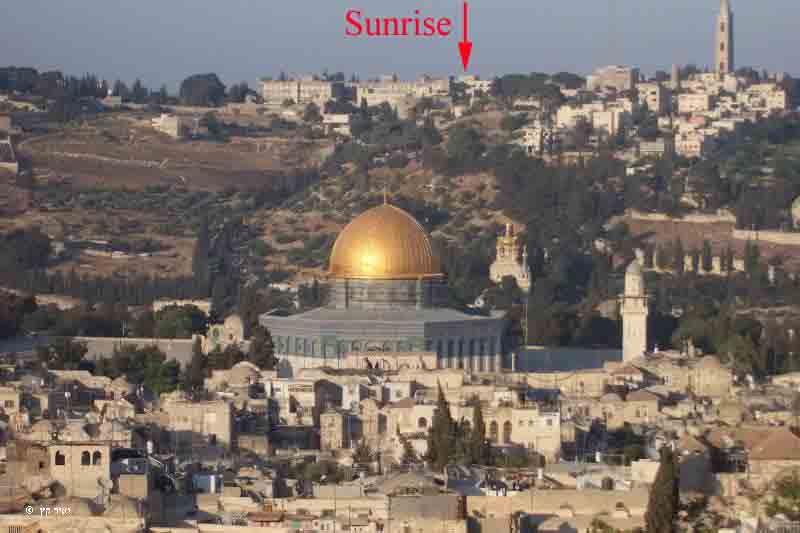
- The ancients were capable of determining true east despite the absence of compasses. The shadow cast by a gnomen (the "finger" that casts a shadow of a sundial) at noon was used to determine true north, and the other cardinal points were established through simple geometry. This method was accurate to within a few degrees.
- What we really need is photographs at sunrise where the camera is oriented directly in line with the Al Kas fountain, where the Holy of Holies was located above. Photos need to be taken at the winter and summer equinox (Dec 21 and June 21) as well as Passover (April 5) and Pentecost (May 31).
- Our
calculations show that the sun rose almost at the magnetic east, at
Passover (April 5).
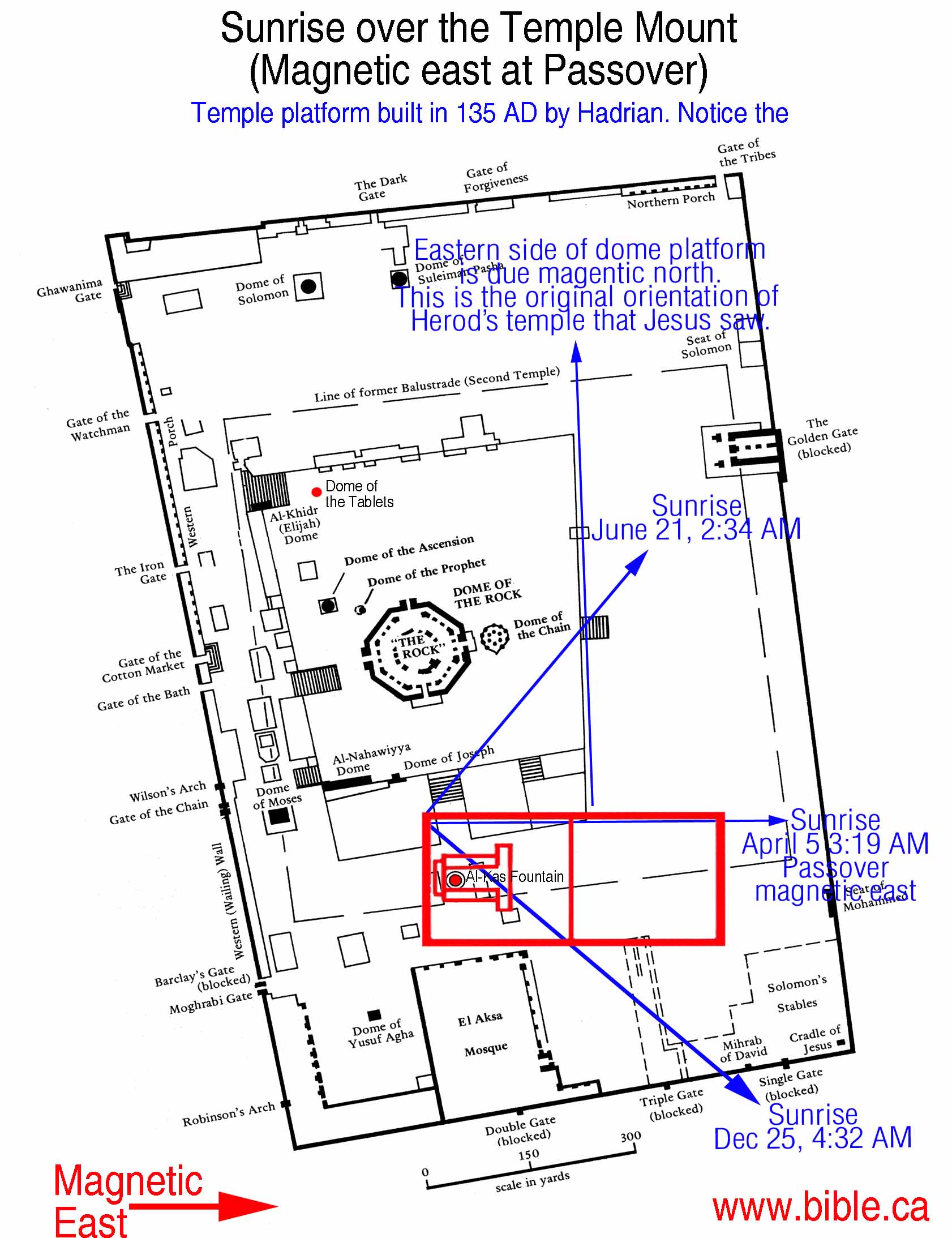
D. Western orientation of Christian churches: (opposite to Hebrew Temple)
1. The first Byzantine church buildings (after 327 AD) were oriented opposite to the Hebrew tabernacle and Temple:
a. While the Hebrews worshipped YHWH with their backs to the rising sun, the earliest church buildings faced the rising sun in the east, perhaps in anticipation to the second coming of Christ “from the east”.
b. “In early centuries, churches were built with the pulpit on the east end. The sun rises in the east, and believers were supposed to look to the east for Christ's return (Matt. 24:27).” (Encyclopedia of 7700 illustrations, To Face The East, 1996 AD)
c. Christians has also suffered mercilessly at the hands of persecuting Jews from the earliest time and the Christians may have wanted to make a departure from Hebrew temple worship.
2. The church grew directly out of Synagogue worship in the first century.
a. Synagogues before 70 AD were randomly oriented on the compass and neither faced east or Jerusalem.
b. After about 150 – 200 AD did synagogues begin facing towards Jerusalem.
c. By the time the first Byzantine churches were constructed, the Jewish synagogues were Jerusalem oriented as opposed to Eastern oriented.
3. Byzantine reasons for east facing worship in 350 AD: "Concerning Worship towards the East: It is not without reason or by chance that we worship towards the East. But seeing that we are composed of a visible and an invisible nature, that is to say, of a nature partly of spirit and partly of sense, we render also a twofold worship to the Creator; just as we sing both with our spirit and our bodily lips, and are baptized with both water and Spirit, and are united with the Lord in a twofold manner, being sharers in the mysteries and in the grace of the Spirit. Since, therefore, God is spiritual light, and Christ is called in the Scriptures Sun of Righteousness and Dayspring, the East is the direction that must be assigned to His worship. For everything good must be assigned to Him from Whom every good thing arises. Indeed the divine David also says, Sing unto God, ye kingdoms of the earth: O sing praises unto the Lord: to Him that rideth upon the Heavens of heavens towards the East . Moreover the Scripture also says, And God planted a garden eastward in Eden; and there He put the man whom He had formed: and when he had transgressed His command He expelled him and made him to dwell over against the delights of Paradises, which clearly is the West. So, then, we worship God seeking and striving after our old fatherland. Moreover the tent of Moses had its veil and mercy seat towards the East. [this is wrong, it was west] Also the tribe of Judah as the most precious pitched their camp on the East. Also in the celebrated temple of Solomon the Gate of the Lord was placed eastward. Moreover Christ, when He hung on the Cross, had His face turned towards the West, and so we worship, striving after Him. And when He was received again into Heaven He was borne towards the East, and thus His apostles worship Him, and thus He will come again in the way in which they beheld Him going towards Heaven; as the Lord Himself said, As the lightning cometh out of the East and shineth even unto the West, so also shall the coming of the Son of Man be. So, then, in expectation of His coming we worship towards the East. But this tradition of the apostles is unwritten. For much that has been handed down to us by tradition is unwritten." (Hilary of Poitiers, John of Damascus. Chapter 12, 81, 315–367 AD)
4. Today Mt 24:27 is misused by premillenialists to teach that Jesus will physically return on foot to Jerusalem from the east: "For just as the lightning comes from the east and flashes even to the west, so will the coming of the Son of Man be." Matthew 24:27. In fact it is a general figure of speech and Jesus could have said, "For just as the lightning comes from the north and flashes even to the south, so will the coming of the Son of Man be." Jesus never intended this to be taken in this way. Further, this passage has to do with the destruction of Jerusalem in 70 AD, not the second coming. Another misused verse is: "In that day His feet will stand on the Mount of Olives, which is in front of Jerusalem on the east; and the Mount of Olives will be split in its middle from east to west by a very large valley, so that half of the mountain will move toward the north and the other half toward the south." Zechariah 14:4. This had to do with Jesus first advent that ended in 30 AD, not the second coming. It is figurative.
Conclusion:
- The Jewish tabernacle, temple and altars worshipped facing east, while the first Byzantine church buildings worshipped facing west.
- The temple of Solomon was located over the threshing floor, which corresponds to about 50 feet directly below where the Al-Kas fountain is located on Hadrian's temple of Jupiter platform that he built in 135 AD.
- It makes logical sense for the easterly orientation to be set at the Sunrise position of the most important day of the Jewish calendar: Passover. On Passover the sun rose absolute due magnetic east.
- Although the magnetic compass was not discovered and in use until about 1000 AD, the ancients were able to easily establish true compass directions through use of the shadow cast by a gnomen at local noon. A stick or other object placed upright in the ground will cast a shadow of varying lengths and directions as the sun moves across the sky. When the sun is at its zenith, the shadow of the gnomen will be at its shortest and will also point due north in the northern hemisphere. This is true regardless of time of year or latitude. The gnomen would have been well-known to the ancient Israelites, having been used extensively both in ancient Mesopotamia, the home of Abraham, and in Egypt, where the Israelites were held in bondage for many years.
- That means that if Moses chose Dec 21 (winter equinox, shortest day of the year) to set his "east" it would point almost exactly magnetic north-east. If Moses chose June 21 (summer solstice, longest day of the year) to set his "east" it would point almost exactly magnetic south-east. If Moses chose the mid point, between Dec 21 and June 21, we arrive at Passover April 5. On April 5, the sun rises due magnetic east. It also rises over the highest point of the mount of Olives.
- Since sunrise happens at true east on Passover, it is logical to assume that the tabernacle of Moses and the Temple of Solomon would have been oriented in that direction. Also, it is logical to conclude that the Temple was located over the Al Kas fountain where sunrise on that day (Passover) would appear over the highest point of the Mount of Olives. In other words, if you erected a large gnomen (like a large telephone pole) on the top of the highest point of the Mount of Olives, it would cast a shadow pointing due west and exactly cross the Al Kas fountain on Passover. Stated alternately, if you were standing on the Al Kas Fountain on Passover, and this gnomen would eclipse the rising sun.
- So by far the most logical choice of the magnetic compass heading orientation of the tabernacle of Moses and the Temple of Solomon was exactly magnetic east for three reasons: It was the mid point of the winter and summer solstice. It was Passover. Due east was marked by the sun that rises over the highest point of the mount of Olives on April 5 every year. Detailed study of how the Holy of Holies of the Temple of Solomon was located directly over the Al-Kas fountain.
- As a matter of speculation, David may have chose the threshing floor for the location of his altar precisely because that was the point at which sunrise on the Passover occurred directly over the highest point of Mount Olives. We need to remember that this is also the precise location where Abraham set up the sacrifice altar for Isaac.
- It is clear that the temple mount platform we see today is a deliberate attempt by Hadrian to remove all remnants of the original east-west orientation of the Jewish Temple. Not only is the platform a trapazoid, rather than a square, there are almost no lines that line up to the compass pointing either due E, W, N S. There is one exception where one line is oriented directly north - south. It is located in the center of the platform. Can you find it?
Detailed study of how the Holy of Holies of the Temple of Solomon was located directly over the Al-Kas fountain
By Steve Rudd: Contact the author for comments, input or corrections.
